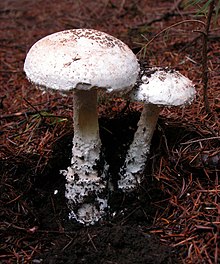| Amanita smithiana | |
|---|---|

| |
| Scientific classification | |
| Domain: | Eukaryota |
| Kingdom: | Fungi |
| Division: | Basidiomycota |
| Class: | Agaricomycetes |
| Order: | Agaricales |
| Family: | Amanitaceae |
| Genus: | Amanita |
| Species: | A. smithiana
|
| Binomial name | |
| Amanita smithiana Bas (1969)
| |
| Amanita smithiana | |
|---|---|
| Gills on hymenium | |
| Cap is convex or flat | |
| Hymenium is free | |
| Stipe has a ring and volva | |
| Spore print is white | |
| Ecology is mycorrhizal | |
| Edibility is poisonous | |
Amanita smithiana, also known as Smith's amanita,[1] is a species of agaric found on soil in coniferous (Abies, Tsuga, Pseudotsuga) and broadleaved (Alnus, Quercus) woodland in the Pacific Northwest of North America. It fruits in August and September.
Description[edit]
The cap has a diameter of 5–17 centimetres (2–6+1⁄2 inches) and is white and scaled with remnants of the universal veil. The stipe is 6–18 cm (2+1⁄2–7 in) long by 1–3.5 cm (1⁄2–1+1⁄2 in) thick, white and similarly scaled, with a ring.[2] The spores are ellipsoid to elongated, amyloid, and measure 11–12.5 by 7–8 µm.[3]
Taxonomy[edit]
Amanita smithiana was described by Dutch mycologist Cornelis Bas in 1969. The specific epithet honors mycologist Alexander H. Smith, who collected the type specimens from Washington in 1941.[3] It belongs in the subgenus Lepidella.
Toxicity[edit]
It is responsible for poisonings in the Pacific Northwest when mistaken for the edible and sought after Tricholoma murrillianum (matsutake). It causes initial gastrointestinal symptoms that manifest 1 to 12 hours after eating the mushrooms,[4] followed by acute nephritis after a delay of 2–6 days. Hemodialysis appears to be an effective treatment and most patients recover normal kidney function within several weeks of ingestion.[5]
It is thought that A. smithiana toxicity is from chlorocrotylglycine and allenic norleucine.[4]
Several similar species have been implicated in similar cases of poisoning: A. sphaerobulbosa, Saproamanita thiersii, A. proxima, (Spain) and A. pseudoporphyria (Japan).[2]
See also[edit]
References[edit]
- ^ "Standardized Common Names for Wild Species in Canada". National General Status Working Group. 2020.
- ^ a b Tulloss RE. "Amanita smithiana". Amanitaceae.org. Retrieved 2014-05-06.
- ^ a b Bas C. (1969). "Morphology and subdivision of Amanita and a monograph of its section Lepidella". Persoonia. 5 (3): 285–579 (see p. 418).
- ^ a b Greenberg, Michael I. (2005). Greenberg's Text-atlas of Emergency Medicine. Lippincott Williams & Wilkins. p. 854. ISBN 978-0-7817-4586-4.
- ^ Saviuc P, Danel V. (2006). "New Syndromes in Mushroom Poisoning". Toxicological Reviews. 25 (3): 199–209. doi:10.2165/00139709-200625030-00004. PMID 17192123. S2CID 24320633.
